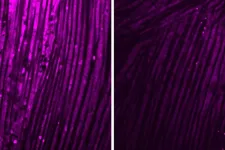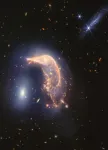(Press-News.org)
In a revelation that highlights the fragile balance of our planet's atmosphere, scientists from China, Germany, and the USA have uncovered an unexpected link between massive wildfire events and the chemistry of the ozone layer. Published in Science Advances, this study reveals how wildfires, such as the catastrophic 2019/20 Australian bushfires, impact the stratosphere in previously unseen ways.
The ozone layer, a crucial shield protecting life on Earth from harmful ultraviolet (UV) radiation, has been on a path to recovery thanks to the Montreal Protocol. This landmark international treaty, adopted in 1987, successfully phased out the production of numerous substances responsible for ozone depletion. Over the past decades, the ozone layer has shown significant signs of healing, a testament to global cooperation and environmental policy.
However, the stability of this vital atmospheric layer is now facing a new and unexpected challenge. During the 2019/20 Australian wildfires, researchers observed a dramatic increase in stratospheric aerosols – tiny particles that can influence climate, health and atmospheric chemistry.
Utilizing advanced satellite data and numerical models, the research team successfully demonstrate the impact of wildfires through a novel phenomenon: the smoke-charged vortex (SCV).
“The SCV is a powerful, smoke-laden whirlpool that transports wildfire emissions into the stratosphere, reaching altitudes of up to 35 kilometers,” explained Prof. Hang Su from the Institute of Atmospheric Physics at the Chinese Academy of Sciences, one of the corresponding authors of the study. “This process led to at least a doubling of the aerosol burden in the southern hemisphere's middle stratosphere. These aerosols, once reaching such high altitudes, initiated a series of heterogeneous reactions that impacted ozone concentrations.”
The international team discovered that these wildfire-induced aerosols facilitated heterogeneous chemical reactions, which paradoxically led to both ozone depletion and ozone increase at different atmospheric layers.
While the lower stratosphere experienced significant ozone loss, they found that the enhanced chemical reactions on aerosols at higher altitudes, i.e., the middle stratosphere, lead to increase of ozone. In Southern Mid-Latitudes, this complex interplay managed to buffer approximately 40% (up to 70%) of the ozone depletion observed in the lower stratosphere in the following months of the mega-bushfire events.
So why does this matter?
“Our study demonstrates an unexpected and crucial mechanism, by which the absorbing aerosols in wildfire smoke, such as black carbon, can induce and sustain enormous smoke-charged vortices spanning thousands of kilometers. These vortices can persist for months, carrying aerosols deeply into the stratosphere and affecting the ozone layer in distinct ways at different altitudes. This highlights the need for continued vigilance and research as climate change progresses,” said Prof. Yafang Cheng, another corresponding author from the Max Planck Institute for Chemistry.
The ozone layer's role in filtering UV radiation is crucial for protecting all life forms on Earth. The Montreal Protocol’s success in reducing ozone-depleting substances was a monumental achievement, but the new findings highlight that natural events, exacerbated by climate change, pose additional risks to this fragile layer. With the increasing frequency and intensity of wildfires driven by global warming, the formation of SCVs and their impact on the stratosphere could become more common, threatening the delicate balance of the ozone layer.
As we continue to grapple with climate change, understanding these newly discovered atmospheric processes is vital. This study opens new avenues for research into how wildfire and other climate-driven events might influence stratospheric chemistry and ozone dynamics in the future.
END
Infections and neurodegenerative diseases cause inflammation in the brain. But for unknown reasons, patients with brain inflammation often develop muscle problems that seem to be independent of the central nervous system. Now, researchers at Washington University School of Medicine in St. Louis have revealed how brain inflammation releases a specific protein that travels from the brain to the muscles and causes a loss of muscle function.
The study, in fruit flies and mice, also identified ways to block this process, which could have ...
Researchers from University of California San Diego have found that two of the most frequently administered stem cell therapies, which are often used interchangeably, actually contain completely different types of cells. The results challenge the current “one-cell-cures-all” paradigm in orthopedic stem cell therapeutics and highlight the need for more informed and rigorous characterization of injectable stem cell therapies before they are marketed for use in patients.
The researchers analyzed cell populations of autologous bone marrow aspirate concentrate (BMAC) and adipose-derived ...
The ozone layer, a crucial shield protecting life on Earth from harmful ultraviolet (UV) radiation, has been on a path to recovery thanks to the Montreal Protocol. This landmark international treaty, adopted in 1987, successfully led to phasing out the production of numerous substances responsible for ozone depletion. Over the past decades, the ozone layer has shown significant signs of healing, a testament to global cooperation and environmental policy.
However, the stability of this vital atmospheric layer is now facing a new and unexpected challenge. During the 2019/20 Australian wildfires, ...
Stories written with AI assistance have been deemed to be more creative, better written and more enjoyable.
A new study published in the journal Science Advances finds that AI enhances creativity by boosting the novelty of story ideas as well as the ‘usefulness’ of stories – their ability to engage the target audience and potential for publication.
It finds that AI “professionalizes” stories, making them more enjoyable, more likely to have plot twists, better written and less boring.
In ...
Researchers at the Texas A&M School of Veterinary Medicine and Biomedical Sciences (VMBS) have uncovered how natural selection “rewilds” domestic rabbits.
The study, published in Nature Ecology and Evolution, helps answer the question of how normally tame rabbits — which have many natural predators — can become a force of ecological destruction when purposefully or accidentally reintroduced to the wild.
Here Comes Peter Cottontail
Every gardener knows how much of a nuisance rabbits can be, but ...
By Leah Shaffer
You can think of our atmosphere as a big chemistry set, a global churn of gaseous molecules and particles that constantly bounce off and change each other in complicated ways. While the particles are very small, often less than 1% of the thickness of human hair, they have outsized impacts. For example, particles are the seeds of cloud droplets, and the abundance of the particles changes the reflectivity and the amount of clouds, rainfall and climate.
Now, researchers at Washington University in St. ...
A recent study from Baylor College of Medicine and Texas Children’s Hospital has identified a specific neural activity pattern as a novel biomarker to accurately predict and monitor the clinical status of individuals with obsessive-compulsive disorder (OCD) who have undergone deep brain stimulation (DBS), a rapidly emerging therapeutic approach for severe psychiatric disorders. The study, led by led by Drs. Sameer Sheth and Wayne Goodman along with co-lead authors, Drs. Nicole Provenza, ...
Two for two! A duo of interacting galaxies commemorates the second science anniversary of NASA’s James Webb Space Telescope, which takes constant observations, including images and highly detailed data known as spectra. Its operations have led to a “parade” of discoveries by astronomers around the world.
“Since President Biden and Vice President Harris unveiled the first image from the James Webb Space Telescope two years ago, Webb has continued to unlock the mysteries of the universe,” said NASA Administrator Bill Nelson. “With remarkable images from the ...
University of Massachusetts Amherst researcher Thomas Mackie has received a $2.1 million funding award from the Patient-Centered Outcomes Research Institute (PCORI) to advance the meaningful engagement of communities that are affected by mental health disparities and underrepresented in research partnerships.
The study, entitled “Improving Research Partnership With Engagement Mapping: A Pilot Study to Advance Engagement Science” and co-led by Karen Tabb, a University of Illinois Urbana-Champaign researcher, is designed to empower community partners to have a greater role ...
Researchers have used gene editing to restore hearing in adult mice with a type of inherited hearing loss. They showed that shutting down a damaged copy of a gene called a microRNA (miRNA) enabled the animals to regain hearing. The approach by a research team supported by the National Institutes of Health (NIH), reported in Science Translational Medicine, may eventually lead to potential treatments for inherited hearing loss in people.
Zheng-Yi Chen, DPhil., and his colleagues at Mass Eye and Ear in Boston and other institutions studied a rare form of genetic deafness called autosomal dominant deafness-50 (DFNA50). ...


